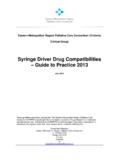Transcription of Analgesic Prescribing with Renal or Liver …
1 Analgesic Prescribing with Renal or Liver Impairment for palliative care Patients Dr Thiru Thirukkumaran Lecturer in palliative Medicine CMO - palliative Medicine Rural Clinical School Burnie palliative care Services University of Tasmania Northwest Tasmania Learning Objectives Understand the impact of Renal and Liver impairment on Analgesic Prescribing in palliative care learn about referral options for patients with Renal and Liver impairment on the NW Coast Outline the Session What are the issues with Kidney / Liver Impairment and using analgesics ? Clinical Scenario with Renal Impairment Renal Impairment Available analgesics in Renal impairment Clinical Scenario with Liver Impairment Liver Impairment Available analgesics in Liver impairment Referral Options in NW Tasmania MCQ x 3 History: 57 years old Mr R with Metastatic Prostate Carcinoma with Bony metastasis.
2 Had DXT; now on Hormone therapy. Stable disease (PSA = 23) 3/12 ago. He is admitted with 2/52 history of drowsiness, jerks & ache in back & legs. Unable to walk with movement related pain. Previously, he was reasonably active (AKPS = 90%) and admitted with poor functional-status (AKPS = 40%). Investigations: B/L Hydronephrosis; eGFR = 25 & Cr = 234 & PSA = 210. Current Pain Medications: He is on MS Contin 60 mg BD + Endone (5mg x 2) prn + Panamax 2 tab tds What are the issues you find in this patient? What is your immediate management? What are the next step of management? What are the issues you find in this patient? Prostate cancer disease progression leads to B/L Hydronephrosis. B/L Hydronephrosis Renal impairment Accumulation of opioid metabolites His usual opioid dose become toxic Toxic Symptoms Increased pain despite of current medications How do we manage Opioid Toxicity ? Opioid Toxicity Opioid Switch Reduce the current Opioid by 30-50% Toxic Symptoms & No Pain Toxic Symptoms & Increasing Pain What is the aim of immediate management in this patient?
3 Pain Control Use Renal friendly opioid and prevent further Renal damage It helps in Toxicity, Drowsiness & Improve AKPS How are you going to do? Opioid Switch Opioid Switch Available Renal friendly opioids for this patient s eGFR (= 25) are: Hydromorphone - oral } Short acting drug - sub cut Inj } - Syringe Driver over 24 hours Fentanyl - Patch (long Acting) - Durogesic Patch - Lozenge (Short Acting) - Actiq Lozenge - Injection (short acting) Alfentanyl Injection (only form) - Syringe Driver for 24 hour - Sub cut Inj (short acting - prn) Weekly Norspan patch Max dose: 40mcg / hour; if more than 40mcg/hr required, we switch to fentanyl patch!
4 How to do the Calculation for this patient? The equivalent dose MS Contin 60mg po BD = Total of 120mg Morphine (Oral) Hydromorphone [ 120mg / 6 ] = Total 20mg Hydromorphone (Oral) = Total of 7mg Hydromorphone in the Syringe Driver over 24 hours (3:1) Alfentanyl [ 120mg / 30] = Alfentanyl 4mg sc in syringe Driver Fentanyl [90mg Morphine = 25mcg/hr Fentanyl patch] = Fentanyl Patch approx. /hr (Next available patch is 25 +12 mcg/hr) Why NOT Norspan Patch Here? The required Norspan patch exceed 40mcg/hr How to Calculate the Patch Transdermal Fentanyl patch and oral Morphine Conversion Ratio: Transdermal Fentanyl patch : Oral Morphine = 1 : 150 (Ratio varies from 100 to 150 But taken as 150; Reference: APM; European Pal care guidelines) E.
5 G.: Patient is on 25 mcg/hr Fentanyl patch; What is the equivalent Morphine ? = 25 [mcg / hour patch] x 24 [hours] x 150 [conversion ratio] = 90 mg Oral Morphine 1000 [to make milligrams] Transdermal Buprenorphine patch and oral Morphine Conversion Ratio: Transdermal Norspan patch : Oral Morphine = 1 : 60 (Ratio varies from 60 to 100 But taken as 60 ; Reference: APM; European Pal care guidelines) : Patient is on 10 mcg/hr Norspan patch; What is the equivalent Morphine ? = 10 [mcg / hour patch] x 24 [hours] x 60 [conversion ratio] = mg Oral Morphine 1000 [to make milligrams] Next step of management for this Opioid Titration to achieve better pain control Using adjuvant medications according to opioid response Contact Oncology Team; inform the admission symptoms; Patient s functional status & his PSA level on this time!
6 For further active Drug Metabolism Drug Metabolism The Liver is the primary organ for clearance of most drugs. Non-polar, lipid-soluble drugs are converted to more polar and water-soluble compounds. Water soluble drugs are excreted unchanged in the kidneys by glomerular filtration and / or Renal tubular secretion. Drug metabolism in Liver is classified in two phases: Phase I: reactions involve oxidative, reductive or hydrolytic reactions that are commonly catalysed by the mixed function oxidase system. The cytochrome P450 is the major enzyme system for oxidation of drugs. Phase II: reactions "conjugate" a water soluble entity, forming a more polar and water soluble metabolite that can be more easily excreted in the urine and/or bile. Drug Metabolism In patients with Liver failure, reduced metabolism usually results in accumulation of the parent drug in the body with repeated administration. When patients with Renal or hepatic dysfunction receive opioid analgesics , it is essential to understand and consider how opioid pharmacokinetics can be altered ?
7 This is necessary to ensure appropriate pain relief for the patient while limiting serious and potentially preventable adverse effects such as respiratory depression, hypotension, or CNS toxicity from either the parent drug or its metabolites. Drug Metabolism in Renal / Liver impairment Vicious Cycle of Opioid-Induced Neurotoxicity Seizures, Death Opioid tolerance Mild myoclonus ( : with sleeping) Severe myoclonus Delirium Agitation Misinterpreted as Pain Opioids Increased Hyperalgesia Misinterpreted as Disease-Related Pain Opioids Increased Analgesic USE IN Renal IMPAIRMENT How to measure Renal function? Traditionally serum Creatinine has been used as a measure of Renal function. This is inaccurate as patients may have a clinically significant deterioration in Renal function while still having a serum Creatinine within the normal reference range.(Lamb et al) Glomerular filtration rate (GFR) is a preferable measure of Renal function.
8 There are two generally accepted methods of estimating GFR 1. Cockcroft + Gault equation 2. 4 variant modification of diet in Renal disease equation (4vMDRD) Both methods are inaccurate at extremes of age and body weight. Estimated GFR (eGFR) is now provided with biochemistry results and is based on the 4vMDRD calculation. (It will not have been adjusted for body total surface area). eGFR classification of Renal impairment Degree impairment Chronic Kidney Disease (CKD) stage eGFR ml/ Creatinine Clearance ml/min Normal Renal function 1 >90 120 Mildly reduced Renal function in presence of Renal disease. In absence of Renal disease eGFR > 60 is considered normal 2 60-89 20-50 Moderately reduced Renal function 3 30-59 10-20 Severely reduced Renal function 4 15-29 <10 Very severe. Established (end-stage) Renal failure 5 <15 <10 Renal failure can make patients more susceptible to adverse effects of drugs. In , it causes: An increased bleeding tendency, therefore the risks of NSAIDs and anticoagulants are increased.
9 Increased blood-brain barrier permeability, therefore increased sensitivity to CNS side effects of drugs sedation Renal failure can change Analgesic pharmacokinetics in the following ways: Reduced excretion of drug or metabolites Altered drug distribution: especially if drug is plasma protein bound Reduced oral absorption: vomiting diarrhoea or mucosal oedema analgesics can still be prescribed according to the WHO Analgesic ladder STEP 1 - analgesics in Renal Impairment Paracetamol: GFR 20-50 = no dose adjustment (1gram Qid) GFR 10-20 = no dose adjustment (1gram Qid) GFR <10 = Reduced dose ( 500mg-1g tds) NSAIDs: Should be avoided even in mild Renal impairment. STEP 2 analgesics in Renal Impairment Codeine / Panadeine / Panadeine forte (Half life significantly prolonged in chronic Renal failure). Mild RF maintain normal dose Moderate RF 75% dose Severe RF 50% dose Tramadol: ( Usually, not recommended in palliative care !)
10 (Active metabolite excreted via kidney) Mild RF - normal dose 50-100mg Qid Moderate RF increase dosing interval 50-100mg bd Severe RF avoid Buprenorphine: Metabolised in the Liver to inactive norbuprenorphine; Therefore, safe to use in patients with Renal impairment. No dose adjustments in Transdermal preparations. (Reduce dose of SL buprenorphine by 25% in severe Renal impairment). STEP 3 analgesics in Renal Impairment -1 Morphine: Morphine and its metabolites accumulate in Renal failure and should therefore be avoided. (In my Practice, I monitor patient s Renal impairment (up to eGFR =40-50with morphine; If they are clinically deteriorated or showing toxic symptoms I switch the opioids. Another set of patients with mild Renal impairment & on morphine are comfortable / pain-free & eGFR is stable at the same level we continue the morphine but monitor them carefully with periodical check of eGFR).)
![[P] Clonazepam - Palliative Care](/cache/preview/7/3/1/8/c/1/0/f/thumb-7318c10f561f7c7ba618d52f79801a4d.jpg)







